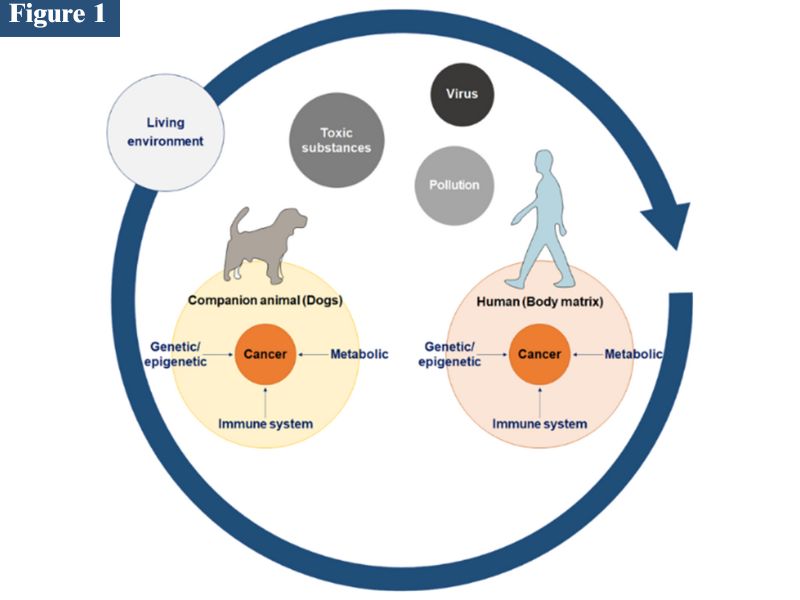
Gastroenterology, the branch of medicine concerned with diagnosing and treating gastrointestinal (GI) disorders, plays a critical role in human and canine health. Despite some differences between human and canine GI physiology, there are substantial commonalities that underpin the gastrointestinal functions of both species and their responses to diseases and drugs, including cancer and various forms of cancer treatments.
Canines vs. humans
Both canine and human GI tracts share essential functional components, including a similar overall structure: oral cavity, esophagus, stomach, small intestine (duodenum, jejunum, ileum), and large intestine (cecum, colon, rectum). Both species use similar digestive enzymes and absorption mechanisms, underscoring their fundamental physiological congruence. Canine and human GI systems share fundamental physiological processes, including digestion, absorption, and excretion.
The basic architecture of the GI tract—comprising the oral cavity, esophagus, stomach, small intestine, large intestine, and accessory organs like the liver and pancreas—is consistent across both species.
Despite these similarities, there are several critical differences:
- Microbiota composition. Canines and humans host similar gastrointestinal microbiotas, with dogs being closer to people than pigs or mice.1 Interestingly, the gut microbiota in dogs and humans correlates with body weight, and significant alterations of microbiota populations are observed in overweight individuals.2
- Anatomy and digestion. Dogs have a shorter GI tract compared to humans. This anatomical difference results in a more rapid transit time for food, which impacts nutrient absorption and digestion efficiency.3 The canine stomach also has a more pronounced glandular area, reflecting adaptations for different dietary compositions.
- Secretions and motility. Gastric acid secretion rates and the regulation of gastric emptying can differ. Dogs exhibit more pronounced gastric acid secretion and have a faster gastric emptying rate compared to humans, which has implications for drug absorption and managing gastrointestinal disorders.3
- Gastric pH and digestion. Canines have a more acidic gastric environment than humans. This higher acidity reflects their evolutionary adaptation as scavengers with a diet that may include carrion and other uncooked food. On the other hand, humans have a slightly less acidic environment due to their evolved diet and cooking practices.
- Gastric emptying time. Dogs typically have a faster gastric emptying time compared to humans. This can impact the duration and efficacy of drug absorption, influencing how gastrointestinal drugs and chemotherapy agents work.
- Intestinal length and function. The relative lengths of the small and large intestines differ between species. Dogs have a shorter small intestine and a longer large intestine relative to body size compared to humans. This anatomical variation affects digestion and absorption efficiency, influencing the presentation and management of gastrointestinal diseases.4
Cancers that can cause diarrhea
Both canine and human cancers can lead to diarrhea through various mechanisms, such as tumor-related obstruction, secretion of gastrointestinal hormones, or direct invasion of the GI tract. However, the types of cancers commonly associated with diarrhea can differ:
Humans
Colorectal cancers and cancers of the small intestine are frequently associated with diarrhea. Additionally, systemic cancers like lymphoma can involve the GI tract secondarily, leading to symptoms like diarrhea.
Canines
Similarly, dogs with lymphosarcoma (lymphoma) often present with GI signs, including diarrhea. Gastrointestinal tumors, such as adenocarcinomas of the stomach and intestines, can also cause similar signs. However, the incidence and types of cancers leading to diarrhea can vary based on breed predispositions and environmental factors.
Cancer therapy-related diarrhea (CTD)
Cancer therapy-related diarrhea (CTD) occurs in both humans and dogs due to the cytotoxic effects of chemotherapy and targeted therapy agents on the rapidly dividing cells that line the GI mucosa. The pathophysiology of CTD is similar across both species, involving mucosal damage, breakdown of barriers between mucosal cells, and a disruption of the normal gut flora. Key points of comparison include:
- Incidence and severity. In both humans and dogs, CTD can be severe and impact the overall health and treatment efficacy. Diarrhea may be severe enough to warrant a reduction or elimination of the offending chemotherapy agent. The specific incidence rates and the severity of diarrhea can vary due to differences in the chemotherapy regimens and individual responses.
- Management strategies. Managing CTD involves supportive care, including hydration, nutritional support, and medications to manage diarrhea. In both species, a variety of anti-diarrheal medications, probiotics, and dietary adjustments are used to alleviate signs and symptoms and support recovery.
- Impact on quality of life. Diarrhea can significantly impact the quality of life for both human and canine patients undergoing cancer treatment. Effective management is essential to prevent dehydration, electrolyte imbalances, and malnutrition, which can further complicate the treatment regimen.
CTD
In people: In human oncology, CTD is a common side effect, impacting up to 90 percent of patients receiving cancer therapy. Drugs, such as 5-fluorouracil (5-FU), irinotecan, neratinib, and cisplatin, are well-known for causing CTD. These agents cause mucosal damage in the gut, disrupt the intestinal microbiota, and affect electrolyte absorption.
The consequences are not only frequent watery stools but dehydration and electrolyte imbalances, which can be severe and necessitate medical intervention. The dehydration and intestinal damage can also be severe enough to require a reduction in the dose of cancer treatment or a change to a different cancer therapy.
In dogs: CTD is similarly observed in dogs, though the incidence and severity can vary based on the specific chemotherapy regimen used. Common chemotherapeutic agents such as doxorubicin, cyclophosphamide, and vincristine can induce diarrhea in canines. The pathophysiology of CTD in dogs mirrors that in humans, involving mucosal damage, alterations in the gut microbiota, and disruption of normal GI function.
However, the manifestation of CTD in dogs differs slightly. Canine patients often show clinical signs such as increased frequency of defecation, watery stools, or diarrhea with blood or mucus. The clinical presentation can be subtle or severe, and the response to treatment may vary based on the dog’s overall health, breed disposition, the type of chemotherapy or targeted therapy agent used, and pre-existing GI conditions.
Oncology drugs used in both humans and dogsMany oncology drugs we are familiar with in veterinary medicine are also used to treat people, reflecting the shared principles of cancer treatment:
|
One Health concept
The One Health concept emphasizes the interconnectedness of human, animal, and environmental health. It recognizes diseases affecting one species can impact others and collaborative approaches are essential for advancing health outcomes across species.6 Comparative oncology, which studies cancer across species to improve understanding and treatment, is a critical component of the One Health framework.
- Advancement of treatments. Comparative oncology leverages the similarities in cancer biology between dogs and humans to advance therapeutic strategies. Canine models provide valuable insights into the efficacy and safety of new treatments, which can subsequently be translated to human medicine. For example, the study of canine osteosarcoma has provided critical insights into developing new treatment modalities for human patients.7,8
- Understanding disease mechanisms. The study of cancers that occur naturally in dogs can enhance our understanding of the molecular and cellular mechanisms underlying tumor development and progression. This comparative approach can lead to the identification of novel biomarkers and therapeutic targets relevant to both species.
Comparative oncology: benefits and insights
Comparative oncology, the study of cancer across different species, offers significant insights into the pathophysiology of cancer and its treatment. Under the One Health concept, the similarities between canine and human cancers (Figure 1), such as the occurrence of similar tumor types and the response to analogous treatments, provides a unique opportunity for mutual benefit.5

- Shared tumor types. Both species experience similar types of tumors, such as lymphoma, osteosarcoma, and mammary tumors. Studying the pathophysiology and the treatment of these cancers in dogs can help translate findings to human medicine and vice versa.
- Drug development. Canine clinical trials often serve as a prelude to human trials. Dogs with spontaneous cancers offer an in vivo model to test the efficacy and safety of new drugs, providing valuable data before moving on to human studies.
- Treatment regimens. Insights gained from managing CTD in dogs can improve human treatment protocols. Conversely, advancements in human oncology can benefit veterinary practices by providing access to newer therapeutic agents and more effective anti-diarrhea treatment protocols.
Conclusion
The study of gastrointestinal physiology in canines and humans reveals substantial similarities that can be leveraged to advance medical knowledge and cancer treatment strategies. Comparative oncology enhances our understanding of cancer therapies and their effects on the GI tract, particularly in the context of CTD. By exploring the intersections between human and canine medicine, researchers can drive innovations that benefit both species, ultimately leading to improved health outcomes and quality of life in both dogs and people suffering from cancer.
The ongoing collaboration between veterinary and human medical research underscores the importance of comparative studies in addressing complex medical challenges. As we continue to bridge the gap between species, the insights gained will not only refine our approach to cancer treatment but also foster a more holistic understanding of gastrointestinal health and disease.
Michael K. Guy, DVM, MS, PhD, is vice president of Preclinical and Nonclinical Studies of Jaguar Health. Dr. Guy has more than 25 years of experience in animal and human pharmaceutical development. He has background in clinical development, manufacturing, regulatory, and pre-clinical drug discovery, and has worked at Amgen, Heska, Colorado Serum Company, Lloyd Pharmaceuticals, Virbac Animal Health, and most recently, the Morris Animal Foundation, where he created the Golden Retriever Lifetime Study.
References
- Coelho, L.P., Kultima, J.R., Costea, P.I., et al. (2018). Similarity of the dog and human gut microbiomes in gene content and response to diet. Microbiome. 6:72, 1-11.
- Chun, J.L., Ji, S.Y., Lee, S.D., Lee, Y. K., & Kim, K.H. (2020) Differences of gut microbiota composition based on the body condition scores in dogs. Journal of Animal Science Technology. Mar;62(2), 239-246.
- Dressman, J.B. (1986). Comparison of canine and human gastrointestinal physiology. Pharmaceutical Research. 3(3), 123-131.
- Furness, J.B., Cottrell, J.J., & Bravo, D. (2015). Comparative gut physiology symposium: Comparative physiology of digestion. Journal of Animal Science. 93(2), 485.
- Oh, J.H. & Cho, J-Y. (2023). Comparative oncology: overcoming human cancer through companion animal studies. Nature. 55, 725-734.
- Pitt, S.J. & Gunn, A. (2024). The one health concept. British Journal of Biomedical Science. February (81), Article 12366.
- Simpson, S., Dunning, M.D., de Brot, S., Grau-Roma, L, Mongan, N.P., & Rutland, C.S. (2017). Comparative review of human and canine osteosarcoma: morphology, epidemiology, prognosis, treatment and genetics. Acta Veterinaria Scandinavica. 59:71, 1-11.
- Simpson, S., Rizvanov, A.A., Jeyapalan, J.N., de Brot, S., & Rutland, C.S. (2022) Canine osteosarcoma in comparative oncology: Molecular mechanisms through to treatment discovery. Frontiers in Veterinary Science. Dec 8(9), 1-12.
